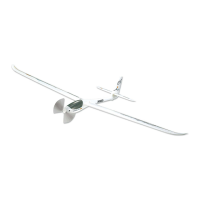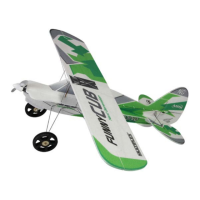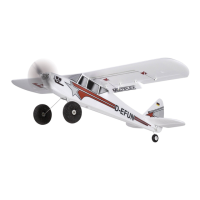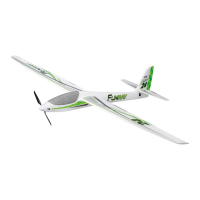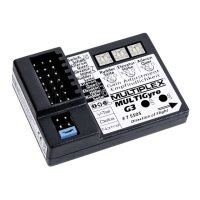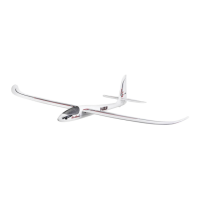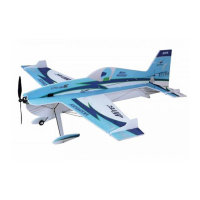12
Building instructions
Important: before you start building
Please ensure that all the model components are present in the kit by
checking them off in the Parts List on page 10 and 11.
It is important to build the model on a clean and perfectly at surface to
ensure that the structure is free of warps, and that the components are
not damaged during assembly. Be sure to cover the building board with
clear plastic lm to avoid the components sticking to the surface.
Joints between EPP components are best made using UHU
®
POR. This is
the procedure: apply a thin lm of adhesive to both surfaces to be glued,
then allow it to air-dry for about eight minutes before pressing the parts
together. The strength of the joint is determined by the pressure you exert,
rather than the length of time you exert it.
When CFRP rods and strips have to be inserted into EPP parts, press
the strip into the appropriate slot, then run low-viscosity (thin) Zacki-
ELAPOR
®
super liquid along it. A little activator spray will harden the
adhesive immediately.
All other glued joints can be made using standard Zacki-ELAPOR
®
.
Although the carbon rods and strips are supplied cut to length, you
may need to trim them slightly. If the correct length is not stated, we
recommend that you hold the strip in position, and cut it to length using
pliers or side-cutters. The kit includes an ample supply of carbon strip.
1. Preparing the individual components
The control surface hinges need to be rendered more exible to ensure
that they move freely when the model is ying. This is accomplished by
folding the control surfaces through 180° before construction; leave them
in this position for about an hour.
Fig. 1
Cover a clean, at surface with clear plastic lm, and lay the n
⓯
on
it, left-hand side facing up as shown. Glue the rectangular-section CFRP
strip
㊳
in the slot in the rudder. The rudder horn
㊻
can now be glued
in the slot.
Fig. 2
Glue the tailplane
⓾
to the fuselage centre section
5
, then glue two
CFRP rectangular-section strips
㊱
in place.
Fig. 3
Now turn the fuselage centre section over, and glue the CFRP rectangular-
section strip
㊲
to the top of the fuselage.
Fig. 4
Glue the two halves of each wing together
6
+
7
,
8
+
9
then glue
the wings to the corresponding wing in-ll pieces
⓳
,
⓴
. The two
rectangular-section strips
㉟
can now be tted to each wing.
Fig. 5
Glue the two undercarriage mounting plates
to both sides of the lower
fuselage section
4
.
Fig. 6
Glue two CFRP rods in each of the aileron pylons
⓫
,
⓬
,
⓭
,
⓮
; cut
the CFRP rod
㉕
to length for these parts.
Fig. 7
Glue two CFRP rods in each of the wing struts
⓰
,
⓱
; cut the CFRP rod
㉖
to length for these parts. Note that the four CFRP rods must cross
over as shown.
Fig. 8
Glue one wheel spat support
to the inside of each wheel spat
㉑
,
㉒
.
Fig. 9
2. Stiffening the wings
Glue the aileron pylons to the underside of the upper and lower ailerons.
Brace each of the pylons to the ailerons using four CFRP rods; cut the
CFRP rod
㉕
to length for these parts. The aileron horns
㊹
,
㊺
can
now be glued to the lower ailerons, and the wing joiners
㊷
,
㊸
in the
upper wing.
Fig. 10
3. Fitting the lower fuselage section
Glue the lower fuselage section
4
to the fuselage centre section
5
,
ensuring that the parts are straight, and at right-angles to each other.
Glue the two undercarriage legs
㊴
in the mounting plates on the
fuselage.
Glue the CFRP rods
㉕
in place at the nose to stiffen this area. Cut the
CFRP rods
㉕
to the correct length, and install them as shown in order
to stiffen the remainder of the fuselage. The best method is to hold the
rod in place on the model, and cut it to the required length using pliers or
side-cutters.
Fig. 11
Glue the undercarriage legs and the CFRP wheel axles
㉞
to the axle
brackets
㊾
,
㊿
. Remember to make one left-hand and one right-hand
assembly.
Fig. 12
Now t each wheel on its axle followed by a spacer ring
, and secure
the spacer rings with a drop of glue. Check that the wheels are free to
rotate.
Fig. 13
4. Installing the rudder and elevator servos, the elevator horn and
the wheel spats
The next step is to glue the elevator and rudder servos (both Hitec HS-40)
in the appropriate openings in the fuselage using a few drops of Zacki
®
.
Glue the elevator horn
㊼
in the elevator.
Fit the spats on the wheel axles. If you wish, these can be secured with a
drop of adhesive to prevent them rotating.
Fig. 14
5. Fitting the upper fuselage section and the wings
The upper fuselage section can now be glued to the fuselage centre
section, taking care to keep the parts straight and at right-angles to each
other. Glue two CFRP rods
㉕
in place to brace the cabane. The rewall
㊶
can now be glued securely to the front of the fuselage. The n is NOT
installed at this stage.
Fig. 15
.
6. Gluing the wings in place
Glue the upper wing to the fuselage. For the next stage the model can be
laid upside down on a at surface. The canopy rests on the base surface
ush with the upper wing; this makes it much easier to align and install
the wing struts accurately. Glue the left and right wing struts
⓰
,
⓱
to
the upper wing.
Now glue one CFRP rod
㉗
and one CFRP rod
㉘
on each side to brace
the wing to the fuselage, crossing over as shown.
Fig. 16
EN
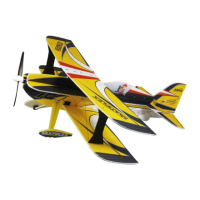
